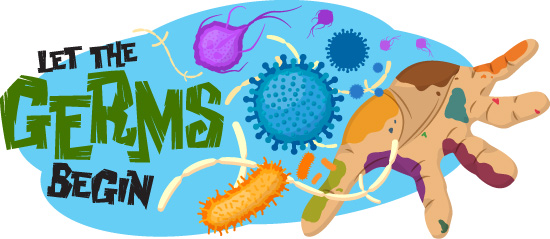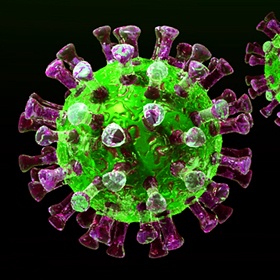
Illustrated by: James Baxter, Gustavo Castañeda
Have you ever wondered why you get sick? The answer is germs. Germs are tiny organisms that make you feel sick and cause disease. We come in contact with millions of germs every day. There are different kinds of germs: bacteria, fungi, viruses, and protozoa.
 Germs are parasitic, which means they gobble up nutrients and energy from other organisms (like us). This process causes someone who has trouble fighting off the germs to show symptoms of common infections like fevers, sniffles, rashes, coughing, vomiting, and diarrhea, just to name a few.
Germs are parasitic, which means they gobble up nutrients and energy from other organisms (like us). This process causes someone who has trouble fighting off the germs to show symptoms of common infections like fevers, sniffles, rashes, coughing, vomiting, and diarrhea, just to name a few.
Now that we know germs cause sickness, how do you think germs are spread? Germs can be spread many ways, including three types of transmission (or passing of germs): direct, indirect, and airborne. Direct transmission means person-to-person contact occurs, and the germs are passed that way. Indirect means that someone spread germs onto an object and when the next person touched that object, the germs spread. Germs can also travel through the air to move from one person to another.
With all these different ways for germs to be passed around, you might wonder if there's a way to avoid germs from getting to you. While we can’t really avoid germs altogether, we can take care of ourselves by washing our hands and covering our mouths when sneezing, among other things. This helps reduce the spread of germs.
During this activity you will illustrate the steps germs take during transmission. You will learn about the different types of bacteria, how they are spread, and discuss ways to keep from getting sick.
What You Need
- Sheet of paper
 Pencil
Pencil- Cups of water
Procedure
Welcome to the beginning of a four-day festival of germs! Each day you will learn or do something new and germy.
Day One
Read the Puzzling Pathogens story and discuss it with the rest of your class.
Day Two
Listen to a short presentation and do three activities that will teach you how those jolly germs jump from one person to another (this is called transmission).
- Direct transmission. Get a cup of water from where your teacher has set them up (don't drink it!). One will have a special chemical in it. You are going to see how just one person with a cold can spread it to many people. You will pour a little bit of your water into three other students' cups. Make sure to write down whose cup you put water into. Your teacher will then tell you who started out infected and from there, you will try to figure out who all should be infected. At the end of the activity, your teacher will come around and put one drop of another chemical into each cup. Those "infected" will end up with red water.
- Indirect transmission. This is a surprise activity that you will have to wait to learn about from your teacher.
- Airborne transmission. One student in class will get to use the spray bottle. They will point it in one direction and spray. Everyone else should stand around, trying to feel whether water from the spray bottle reached them. If you feel water land on you, raise your hand. Those that didn't get sprayed will use a meter stick to measure the furthest distance the water traveled.
Day Three
 Work on making a tree map. This will be a chart with bacteria, viruses, fungi, and protozoans listed at the top. Your teacher will prompt you with three or four questions related to these organisms. Then, you will watch a PowerPoint presentation and fill out your charts so they contain the answers to the questions in the appropriate columns.
Work on making a tree map. This will be a chart with bacteria, viruses, fungi, and protozoans listed at the top. Your teacher will prompt you with three or four questions related to these organisms. Then, you will watch a PowerPoint presentation and fill out your charts so they contain the answers to the questions in the appropriate columns.
Day Four
Discuss ways to prevent the spread of germs with the rest of your class. You will split into groups and come up with skits that show how you can protect yourself and your classroom from germs. At the end of the day, you will take a quiz to show how much you've learned.
Read more about: Let the Germs Begin
Bibliographic details:
- Article: Let the Germs Begin
- Author(s): Satina Sund, Vanessa Vierkoetter, Esmeralda Manzano, Julie Dunlap
- Publisher: Arizona State University School of Life Sciences Ask A Biologist
- Site name: ASU - Ask A Biologist
- Date published:
- Date accessed:
- Link: https://askabiologist.asu.edu/experiments/let-germs-begin
APA Style
Satina Sund, Vanessa Vierkoetter, Esmeralda Manzano, Julie Dunlap. (). Let the Germs Begin. ASU - Ask A Biologist. Retrieved from https://askabiologist.asu.edu/experiments/let-germs-begin
Chicago Manual of Style
Satina Sund, Vanessa Vierkoetter, Esmeralda Manzano, Julie Dunlap. "Let the Germs Begin". ASU - Ask A Biologist. . https://askabiologist.asu.edu/experiments/let-germs-begin
Satina Sund, Vanessa Vierkoetter, Esmeralda Manzano, Julie Dunlap. "Let the Germs Begin". ASU - Ask A Biologist. . ASU - Ask A Biologist, Web. https://askabiologist.asu.edu/experiments/let-germs-begin
MLA 2017 Style

Download the Germs Experiment (PDF).
Be Part of
Ask A Biologist
By volunteering, or simply sending us feedback on the site. Scientists, teachers, writers, illustrators, and translators are all important to the program. If you are interested in helping with the website we have a Volunteers page to get the process started.
